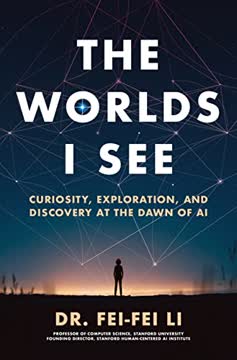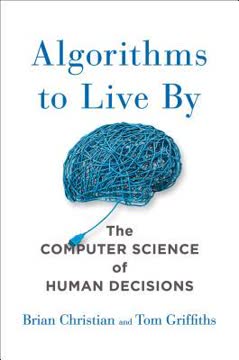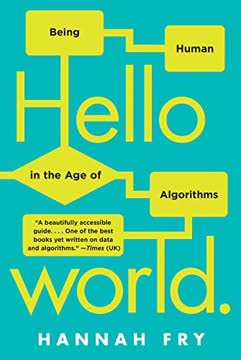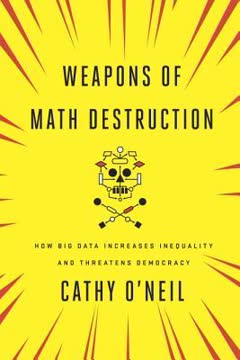Key Takeaways
1. Data Science: More Than Just Hype, It's a Hybrid Field
Data scientist (noun): Person who is better at statistics than any software engineer and better at software engineering than any statistician.
Defining the field. Data science is an emerging discipline born from the convergence of powerful trends like new data collection methods, cloud computing, visualization, and accessible tools. While often shrouded in hype and lacking a single definition, it represents a real shift in how decisions are made and products are built using data. It's not just a rebranding of statistics or machine learning, but a distinct field requiring a blend of skills.
A blend of skills. A successful data scientist possesses a diverse skill set spanning multiple domains. Key areas include:
- Computer science (coding, algorithms, data structures)
- Statistics (inference, modeling, probability)
- Math (linear algebra, calculus, optimization)
- Machine learning (predictive modeling, clustering)
- Domain expertise (understanding the problem context)
- Communication and visualization (telling the data's story)
No single person excels at all, highlighting the value of diverse data science teams.
The data science process. Data science involves a cyclical process: starting with raw data, cleaning and preparing it (data wrangling), performing exploratory data analysis (EDA), building models or algorithms, interpreting results, and often deploying a "data product" that generates more data, creating a feedback loop. This process is iterative and requires involvement from the data scientist at every stage, from initial question formulation to deployment.
2. Statistical Thinking and EDA: The Essential Foundation
“Exploratory data analysis” is an attitude, a state of flexibility, a willingness to look for those things that we believe are not there, as well as those we believe to be there.
Understanding data generation. Statistical inference is the discipline of extracting meaning from data generated by stochastic processes. It involves understanding the relationship between populations and samples, recognizing that even "Big Data" is often just a sample from a larger, uncertain process. Data collection methods introduce uncertainty and bias, which must be considered.
Data is not objective. It is crucial to understand that data is not an objective mirror of reality; it reflects choices made during collection and processing. Assuming N=ALL (having all the data) is often false and can lead to biased conclusions, ignoring voices not captured in the dataset. Beware of the idea that "data speaks for itself" – interpretation is always subjective and influenced by assumptions.
Explore before modeling. Exploratory Data Analysis (EDA) is a critical, often overlooked, step involving visualizing data, calculating summary statistics, and building intuition. EDA helps:
- Gain intuition about data shape and patterns
- Identify missing values, outliers, and errors
- Debug data logging processes
- Inform model building and feature selection
It's a conversation between you and the data, done before formal modeling to ensure you understand what you're working with.
3. Core Algorithms: Tools for Prediction, Classification, and Clustering
Many business or real-world problems that can be solved with data can be thought of as classification and prediction problems when we express them mathematically.
Algorithms for tasks. Algorithms are procedures to accomplish tasks, fundamental to computer science and data science. In data science, key algorithms include those for:
- Data processing (sorting, distributed computing)
- Optimization (finding model parameters)
- Machine learning (prediction, classification, clustering)
Machine learning algorithms, often developed in computer science, focus on predictive accuracy, while statistical models, from statistics, often emphasize interpretability and understanding underlying processes.
Linear Regression. This is a fundamental statistical model used to express the linear relationship between an outcome variable and one or more predictors. It aims to find the line (or hyperplane) that best minimizes the squared distance between observed data points and the model's predictions. While simple, it provides a baseline and its coefficients offer interpretability.
- Model: y = β₀ + β₁x₁ + ... + βₚxₚ + ϵ
- Fitting: Typically uses least squares estimation
- Evaluation: R-squared, p-values, Mean Squared Error (MSE)
Classification Algorithms. When the outcome is categorical (e.g., spam/not spam, high/low risk), classification algorithms are used.
- k-Nearest Neighbors (k-NN): Classifies a data point based on the majority class of its 'k' nearest neighbors in a feature space. Requires a distance metric and choosing 'k'.
- Naive Bayes: A probabilistic classifier based on Bayes' Theorem, assuming independence between features. Works well for text classification (like spam filtering) and scales efficiently.
- Logistic Regression: Models the probability of a binary outcome using the inverse-logit function, allowing direct interpretation of output as probabilities between 0 and 1.
Clustering Algorithms. For unsupervised learning problems where labels are unknown, clustering algorithms group similar data points together.
- k-means: Partitions data into 'k' clusters, where each data point belongs to the cluster with the nearest mean (centroid). Requires choosing 'k' and a distance metric. Useful for customer segmentation or identifying natural groupings in data.
4. Data Wrangling: The Unsung Hero of Data Science
Data science, as it’s practiced, is a blend of Red-Bull-fueled hacking and espresso-inspired statistics.
The reality of data. Raw data is rarely clean, structured, or immediately usable for analysis or modeling. It often comes from disparate sources, in various formats (logs, text, databases), and contains errors, inconsistencies, missing values, and redundancies. Data wrangling, also known as data cleaning, preparation, or munging, is the essential process of transforming raw data into a usable format.
More time than you think. Data scientists often spend a significant portion of their time, sometimes up to 90%, on data wrangling tasks. These tasks include:
- Parsing and formatting data
- Handling missing values and outliers
- Joining data from multiple tables or sources
- Scraping data from the web using APIs or custom scripts
- Debugging data collection processes (logging errors)
Mastery of command-line tools (like grep, awk, sed), scripting languages (Python, R), and SQL is crucial for efficient data wrangling.
Beyond the clean matrix. While academic exercises often start with a perfectly clean data matrix, real-world problems require building robust pipelines to handle messy data. Understanding the data's origin and the process that generated it is vital for effective cleaning and avoiding pitfalls like data leakage. Data wrangling is not just a technical chore; it's a critical analytical step that requires domain knowledge and intuition.
5. Feature Engineering: Unlocking Meaning in Data
Feature extraction and selection are the most important but underrated steps of machine learning.
Transforming raw data. Raw data, even after cleaning, may not be in the most informative format for a model. Feature engineering is the process of creating new variables (features) from the raw data that better represent the underlying problem and improve model performance. This involves domain expertise, creativity, and understanding the data's potential.
Generating features. Brainstorming and generating a comprehensive list of potential features is the first step. This can involve:
- Simple transformations (e.g., taking logarithms, creating binary flags)
- Aggregations (e.g., counting events per user, calculating sums or averages)
- Combining existing features (e.g., ratios, interaction terms)
- Incorporating external data sources
The goal is to capture as much potentially relevant information as possible, even if features are redundant or their relevance is initially unclear.
Selecting the best features. With a large set of generated features, feature selection identifies the most relevant subset for the model. This is crucial for:
- Reducing model complexity and preventing overfitting
- Improving model interpretability
- Speeding up training and prediction
Methods include: - Filters (ranking features based on individual metrics like correlation)
- Wrappers (searching for optimal subsets using model performance)
- Embedded methods (algorithms like decision trees that perform selection during training)
Feature selection is an iterative process, often requiring experimentation and validation on hold-out data.
6. Causality: The Elusive Goal Beyond Prediction
Correlation Doesn’t Imply Causation
Prediction vs. Causality. Many data science models focus on prediction – forecasting an outcome based on input data, optimizing for accuracy. However, a distinct set of problems requires understanding causality – determining if one variable causes a change in another. This is fundamentally harder than prediction and requires different approaches.
The Fundamental Problem. Establishing causality is challenging because we can only observe one outcome for a given unit (e.g., a person): either they received the treatment (e.g., took a drug) or they didn't. We can never know the counterfactual outcome – what would have happened to that same unit if they had received the opposite treatment.
Methods for Causal Inference.
- Randomized Experiments (A/B Tests): The "gold standard." Randomly assigning units to treatment or control groups helps balance confounders (variables affecting both treatment and outcome), allowing the difference in outcomes between groups to be attributed to the treatment on average.
- Observational Studies: Analyzing data collected without experimental control. Prone to confounding bias (like Simpson's Paradox), where unmeasured or improperly accounted-for variables distort the apparent relationship. Methods like propensity score matching attempt to create synthetic control groups to mitigate confounding, but rely on the strong assumption that all relevant confounders have been measured and included.
7. Data Engineering: Taming Data at Scale
MapReduce allows us to stop thinking about fault tolerance; it is a platform that does the fault tolerance work for us.
Big Data Challenges. Working with data that exceeds the capacity of a single machine introduces significant engineering challenges. Beyond storage, issues include:
- Processing speed: Analyzing massive datasets efficiently.
- Fault tolerance: Ensuring computations complete reliably when individual machines fail (which is common at scale).
- Bandwidth: Moving data between machines.
- Complexity: Coordinating work across many distributed systems.
These challenges necessitate specialized tools and frameworks.
MapReduce. Developed at Google and popularized by Hadoop (an open-source implementation), MapReduce is a programming model and framework for processing large datasets in parallel across a cluster of computers. It simplifies distributed computing by abstracting away complexities like fault tolerance and data distribution.
- Mapper: Processes input data records and emits (key, value) pairs.
- Shuffle: Groups all values by their key.
- Reducer: Processes grouped values for each key and emits final outputs.
While powerful for batch processing, it's less ideal for iterative algorithms.
Other Distributed Frameworks. Beyond MapReduce, other frameworks address specific large-scale computational needs.
- Pregel (and Giraph): Designed for large-scale graph processing, enabling nodes to communicate iteratively with neighbors and aggregators.
- Spark: An alternative to MapReduce, often faster for iterative algorithms and interactive data analysis due to in-memory processing capabilities.
Data engineering is crucial for making large-scale data accessible and processable for analysis and modeling.
8. Model Evaluation: Beyond Simple Accuracy
Probabilities Matter, Not 0s and 1s
The Risk of Overfitting. A major challenge in model building is overfitting – creating a model that performs exceptionally well on the training data but poorly on new, unseen data. This happens when the model captures noise or idiosyncrasies specific to the training set rather than the underlying patterns. Complex models are more prone to overfitting, especially with limited data.
Evaluation Metrics. Choosing the right metric to evaluate a model's performance is critical and depends on the problem's objective.
- Accuracy: The proportion of correct predictions. Can be misleading in imbalanced datasets (e.g., predicting rare events).
- Precision: Of all positive predictions, how many were actually positive? (TP / (TP + FP))
- Recall (Sensitivity): Of all actual positives, how many were correctly predicted? (TP / (TP + FN))
- F-score: Combines precision and recall.
- Area Under ROC Curve (AUC): Measures a classifier's ability to distinguish between classes across various thresholds, useful for evaluating ranking performance.
- Mean Squared Error (MSE): Measures the average squared difference between predicted and actual values (for regression or probability estimation).
Evaluating Probabilities. For classification problems, the model often outputs probabilities, not just binary labels. Evaluating the quality of these probabilities is important.
- Calibration: Assesses whether the predicted probabilities match the actual observed frequencies within groups of predictions (e.g., if the model predicts 70% probability, does the event occur 70% of the time in that group?). Some models (like unpruned decision trees) are poorly calibrated.
- Ranking: Evaluated using metrics like AUC or lift curves, assessing how well the model orders instances by likelihood.
9. Data Leakage: The Hidden Pitfall
Leakage refers to information or data that helps you predict something, and the fact that you are using this information to predict isn’t fair.
"Too good to be true". Data leakage occurs when information from outside the training data, or information that would not be available at the time of prediction in a real-world scenario, is used to build a model. This leads to models that perform unrealistically well during testing but fail completely in production. It's a common pitfall in data preparation and feature engineering.
Examples of Leakage. Leakage often stems from temporal inconsistencies or artifacts of data processing:
- Using future information to predict the past or present (e.g., using a "free shipping" flag that appears after a purchase to predict the purchase amount).
- Including data processing artifacts that correlate with the outcome (e.g., patient IDs grouped by clinic severity, or diagnosis codes shifted after removing the target diagnosis).
- Sampling biases that inadvertently reveal information about the outcome.
Avoiding Leakage. Preventing leakage requires meticulous attention to detail and understanding the data's lifecycle.
- Strict Temporal Cutoff: Ensure all data used for prediction was genuinely available before the event being predicted. Timestamp everything.
- Understand Data Generation: Know exactly how the data was collected, processed, and stored.
- Sanity Checks: Question features that are highly predictive – are they truly causal or predictive, or are they artifacts of the data?
- Reproducible Pipelines: Build robust data pipelines that enforce temporal consistency and avoid manual data manipulation that could introduce leakage.
10. Data Visualization: Communicating Insights and Stories
Change the instruments and you will change the entire social theory that goes with them.
Beyond pretty plots. Data visualization is more than just creating aesthetically pleasing graphs; it's a powerful tool for exploring data, communicating findings, and telling compelling stories. It allows humans to perceive patterns and insights in data that would be impossible to discern otherwise, especially in complex or high-dimensional datasets.
Purpose of Visualization. Visualizations serve multiple purposes in data science:
- Exploration (EDA): Understanding data distributions, relationships, and identifying anomalies.
- Communication: Presenting findings clearly and persuasively to diverse audiences.
- Monitoring: Tracking key metrics and identifying trends over time (ambient analytics).
- Product Integration: Embedding visualizations in user-facing applications or internal tools (like risk review dashboards).
Historical Context. The idea of visualizing data to understand complex phenomena has a long history, from early statistical graphics to modern interactive installations. Thinkers like Gabriel Tarde foresaw the potential of visualizing individual-level data to understand society. The field draws on principles from statistics, computer science, design, and journalism.
Tools and Practice. Developing strong data visualization skills requires practice and understanding design principles. Tools range from statistical packages (R's ggplot2) and programming libraries (Python's Matplotlib, D3.js for web) to specialized software. Effective visualization requires choosing the right chart type, encoding data appropriately, and focusing on clarity and narrative.
11. The Human Element: Collaboration, Ethics, and Continuous Learning
It’s perhaps more important in an emergent field than in any other to be part of a community.
Collaboration is Key. Data science problems are often complex and require a diverse range of skills. Effective data science is inherently a team sport, bringing together individuals with complementary expertise (stats, CS, domain knowledge, communication). Learning from others, seeking feedback, and collaborating on projects are essential for growth.
Ethics and Responsibility. Data science is not value-neutral. Choices about what data to collect, how to model, which metrics to optimize, and how to deploy models have real-world impacts on individuals and society.
- Bias: Models can perpetuate or amplify historical biases present in the data.
- Privacy: Handling sensitive user data requires careful consideration and robust security measures.
- Impact: Understanding the potential consequences of deploying a data product or using model results for decision-making is crucial.
Being an ethical data scientist involves cultivating awareness, asking critical
[ERROR: Incomplete response]
Last updated:
Review Summary
Doing Data Science receives mixed reviews. Some praise it as a good introduction to data science, highlighting its broad coverage and real-world insights. Others criticize it for being disjointed and superficial. Readers appreciate the practical advice and industry perspectives but note it's not a comprehensive textbook. The book's structure, based on lecture notes, is seen as both a strength and weakness. While some find it engaging and informative, others feel it lacks depth and coherence. Overall, it's viewed as a decent overview for beginners but not sufficient for in-depth learning.
Similar Books









Download PDF
Download EPUB
.epub digital book format is ideal for reading ebooks on phones, tablets, and e-readers.





